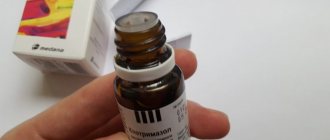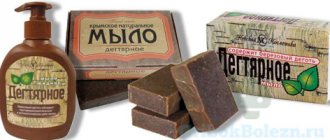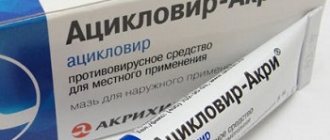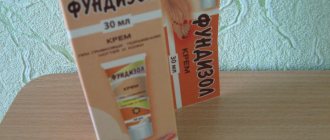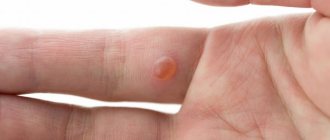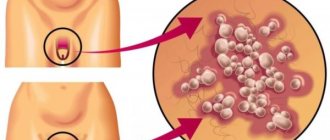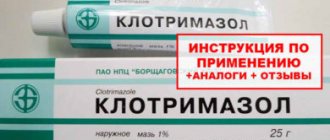A fungal infection of a natural manicure or pedicure can occur after visiting a bathhouse, sauna or water park and contribute to damage to the nail plate. And the lack of treatment leads to its gradual destruction.
When you consult a doctor, he prescribes medications that imply external or internal effects on the disease. One of the effective drugs for eliminating fungus is Clotrimazole. However, pay attention to the features of the composition to increase the efficiency of manipulations.
Release forms
All dosage forms of clotrimazole are intended for external use only .
- 1% Cream - tube 20 g homogeneous mass of white color.
- 1% Ointment – fatty, white, 20 g tube. Separate article about ointment and cream...
- 1% Solution is a clear, colorless liquid with a specific odor in a bottle with a dropper.
- The powder is white to light yellow in color with a peculiar odor. Only one drug containing clotrimazole is available in powder form - Indian-made Candide.
Dosage forms in which the product is produced (there is no powder here)
What to choose
Cream and ointment differ in their base: the ointment is fattier (based on the composition of petroleum jelly and lanolin), the cream has a softer base due to other components. The cream can be applied both to the skin and to the mucous membranes of the body, the ointment can be applied only to the skin.
Clotrimazole solution penetrates the nail keratin , so it is used against nail fungus and also to treat oral fungal infections. It is also acceptable to use on the skin area, especially if it is impossible to use ointments and cream formulations.
The powder has a drying effect on weeping wounds, ulcers with a fungal infection, and also to relieve diaper rash, for example, in skin folds.
Indications for use of Clotrimazole solution
All skin infections that are caused by the presence of yeast, mold fungi (the most common) and dermatophytes (a little less common) are treated with Clotrimazole. If there are pustular infections, mycosis of the skin or feet, then it is better to use ointment. If the nail plate is damaged, it is recommended to use Clotrimazole solution, since it quickly and deeply penetrates into the nail.
It is important for every person to pay attention to their nails: if there are small spots, stripes on them, or an unpleasant odor is created, then there may be a fungus. At the second stage of development of the disease, the nail becomes dark brown and begins to “rot” away from the skin, and even worse when the disease begins to spread to other areas. An effective solution of Clotrimazole should be used in the presence of the first signs of fungal infections and to prevent them when visiting swimming pools, water parks or public places with water.
Composition of the drug
1 ml of solution contains 10 mg of the active substance clotrimazole, an antifungal agent .
Auxiliary components:
- Isopropyl myristate is an emollient, has a softening effect, promotes uniform distribution and application of the drug;
- Ethanol 99.9% (anhydrous) – solvent of the active substance, drying effect.
Chemical formula for the synthesis of the main active ingredient of the same name Clotrimazole
Analogs
Clotrimazole solution is produced by the Polish company Medana. Analog – Candide, Indian manufacturer Glenmark in two versions:
- bottle with dropper volume 15 ml (250 rub.);
- bottle 20 ml (400 rub.).
The drugs are equivalent in effectiveness, as both companies are focused on the European standard.
The subject of choice is the individual reaction to each drug or the particularities of use of an individual patient.
Cheap analogues
Clotrimazole from other manufacturers in solution form is not available in Russia.
Clotrimazole in the treatment of nail fungus
Clotrimazole is a drop for nails that envelops the nail plate and is gradually absorbed into it, ensuring the rapid elimination of pathogenic bacteria that destroy the condition of a natural manicure.
However, the drug also has other forms of release:
- Ointment;
- Gel;
- Solution – whey;
- Spray.
The active ingredients of the drugs are the same, so the drug effectively fights the disease. The only difference is the ease of use and the concentration of components.
The use of drops helps stop the progression of the disease, prevents further proliferation of harmful microorganisms and can completely destroy them. However, the drug is prescribed only to restore the lesion in the initial stages, since complex treatment is prescribed for an advanced form of infection. It additionally includes taking tablets and applying ointments.
Clotrimazole is often prescribed for nail fungus, since the liquid is equally effective on almost all types of nail damage.
Drops are used if there are signs of damage:
- Dark or white spots on the surface.
- The surface has become rough, matte, and there is no natural gloss.
- Numerous detachments appear.
- The nail begins to deteriorate.
- The plate is thinning.
If you use clotrimazole for an ingrown toenail, the solution against nail fungus will help make the skin softer and gradually level the plate, which will smooth out the girl’s problem.
Properties of the drug
Shows an effective effect on:
- Dermatophytes (Trichophyton rubrum, Trichophyton mentagrophytes, Epidermophyton flocossum, Microsporum canis);
- Yeast-like and moldy fungi;
- The causative agent of lichen versicolor;
- The causative agent of erythrasma;
- Gram-negative bacteria and gram-positive bacteria (Staphylococcus, Streptococcus).
How it works
Clotrimazole promotes the death of fungi by affecting the synthesis of ergosterol , the main component of the protective cell membrane. The damaged integrity of the membrane leads to the gradual death of the fungal pathogen.
In low concentrations it acts fungistatically. In large ones it is fungicidal. In increased concentrations, the principle of action of clotrimazole is based on interaction with the enzymes of the fungal cell. As a result of such reactions, hydrogen peroxide accumulates to a concentration toxic to the fungus, which completely destroys it.
Instructions for use
Mode of application
- The first step is to mechanically remove the affected nail , first softening it. For example, make a bath with a soap solution (necessarily soap with a neutral pH) or fix the keratolytic paste with plasters for several hours. Then completely trim the free edge and remove the affected part of the nail.
- Apply a sufficient amount of clotrimazole solution to clean, dry skin around the nail and directly to the nail plate , rubbing in gently.
- Wait until the drug is completely absorbed.
The last point is very important because clotrimazole acts fungicidal, gradually accumulating in the epidermis and in the deep layers of the keratin of the nail.
Trimming the nail and removing the affected area is required throughout the entire treatment period as the free edge grows back.
Dosage
The procedure must be carried out daily, 2 times a day .
Overdose
There is no data on clotrimazole overdose.
Storage conditions
Temperature 15-25 °C, in a dry place protected from light. Keep away from children.
Do not use after expiration date
special instructions
The drug is not intended for the treatment of fungal infections of the skin in the eye area .
If unwanted allergic reactions or irritation occur, stop using.
There is no need to adjust therapy for older patients.
No data available for use in children.
Features of use with other drugs
The low resorption capacity of clotrimazole eliminates negative interactions with other drugs and does not exhibit systemic effects.
The effectiveness of clotrimazole is reduced when used simultaneously with natamycin (Pimafucin), nystatin and amphotericin B.
Application schemes
The duration of treatment for fungal nail infections varies from person to person. For onychomycosis, the use of local external agents is necessary until a new healthy nail appears (from 3 to 6 months or more, depending on the degree of damage).
Clotrimazole is most often prescribed in cases where the nail is affected by no more than one-third , only at the initial stage. Due to the lack of an oral form, systemic therapy with clotrimazole is not possible. Therefore, it is suitable when there are significant contraindications for other drugs and systemic use of antimycotics.
For the full benefit of treatment, regular treatment of shoes, socks, and gloves with antifungal sprays is necessary.
Baths before applying the solution
- Does green tea raise or lower blood pressure?
- How to enlarge lips at home
- Kefir diet for weight loss
Before using Clotrimazole, various foot baths are very useful, which will not only relieve fatigue, but will help get rid of the annoying fungus. These can be mixtures prepared according to folk recipes, or pharmacy versions of herbal infusions, which are recommended to combat the disease in question. Let's highlight the most popular foot baths, which are recommended to be used before Clotrimazole solution:
- Dilute tar soap with warm water, add a few tablespoons of sea salt. Take the bath for 10-15 minutes, simply lowering your feet into it.
- Mix a few grams of manganese and boric acid in a separate container. Dilute this liquid with 2-3 liters of warm water and dip your feet in it. Massage your feet and nails in water for 5 minutes, then pat dry with a towel.
- Combine vinegar essence and pine needle extract in a 1:1 ratio and mix with 5 portions of water. It is allowed to take such a bath for up to 15 minutes, and after it apply Clotrimazole to the affected areas.
- Prepare a paste from several heads of garlic (1-2) and dilute it with 2 liters of cold water, put your feet in the bath, take the treatment procedure for 5-7 minutes, after which you are allowed to rinse.
Contraindications
- Individual sensitivity to clotrimazole and the components of the solution;
- I trimester of pregnancy;
- With caution when breastfeeding.
Under the supervision of a doctor
In the second and third trimesters of pregnancy, during lactation, use only under the supervision of a doctor, in case of justified benefit over the possible risk. However, clinical studies have not revealed any negative effects on the health of the mother and fetus.
Video about the use of the drug during pregnancy:
Side effects
In rare cases, allergic reactions in the form of rash, hives, redness and irritation at the site of application of the solution (itching, burning, peeling of the skin) .
Indications and contraindications
It is impossible to quickly cure mycosis; it is a very long process that requires the patient to fully comply with all prescribed procedures. Many people, having felt the first improvements, stop using the medicine, which is strictly forbidden to do, since this will certainly lead to the secondary appearance of a fungal infection.
The drug is recommended for people who have the following problems:
- pityriasis versicolor;
- mycoses that are caused by various micromycetes;
- various skin pathologies.
Since Clotrimazole is used exclusively externally, it has very few contraindications. These include:
- allergy to any component in the composition;
- pregnancy, especially the first trimester;
- breastfeeding period;
- hepatitis and other liver diseases.
In any case, it is better to be on the safe side and test the product in advance. To do this, apply the cream to the skin and wait 15-20 minutes. If no changes are noted in the treated area, then treatment can begin. If a rash or itching sensation appears, it is better to stop using it. But, as reviews show, Clotrimazole cream for nail fungus rarely causes any side effects.
